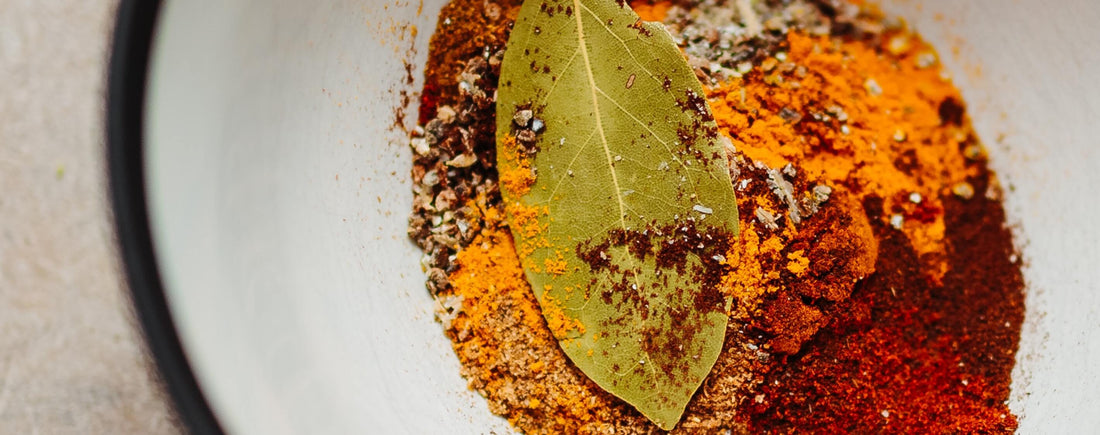As a Western-trained physician, one of the things I appreciate the most about Ayurveda is the wisdom and depth of its nutritional recommendations. Going through medical school, I didn’t learn how to teach people to eat a healthy diet that supported all aspects of our physiology and physical health. I not only struggled to help my patients in this area, but I struggled with my own diet and didn’t know which fad to follow. When I first learned about Ayurvedic nutritional guidelines, it was a game-changer for me, my family, and my patients.
Ayurveda gives us a lot of great information about healthy eating, and one of the most important is understanding the six tastes of life. Ayurveda categorizes foods into six tastes and recommends we try to get at least one ingredient from each taste in every meal. Although that may initially feel daunting, it’s actually one of the easiest and most fun ways I have ever eaten. In fact, many foods fit into more than one taste, therefore it becomes easy to knock out all six tastes, as you will see below.
The idea is that each taste provides us specific benefits and when we include all six tastes in our diet, our body gets everything it needs. The taste categories are not necessarily based on a knowledge of the molecular structure of food, but how the food tastes and/or effects the foods have on the body. In this regard, we can all become our own food scientists! Once I became familiar with the six tastes, I felt empowered to make choices that were giving my body what it needed. And, as a result, my daily cravings went away.
Let’s explore the six tastes and how each taste supports us.
Not only does this category include things that taste sweet, like sugar, it’s also the taste of energy foods. Said another way, these are the foods that give us the most energy, or calories. This taste includes all carbohydrates, proteins, and fats. We need these foods to function. When we restrict calories too much, we don’t have energy, the body tries to conserve, and we may end up gaining weight. In residency training, I often saw patients who didn’t eat a lot of calories but gained weight. My attending physicians had no explanation and assumed the patients weren’t truthful about their intake. However, since these patients’ experiences were also my experience, I knew there had to be an explanation. That being said, if we eat too many caloric foods, we will gain weight, so the key is balance in portion size—as well as eating the healthiest foods in the sweet taste category.
From an Ayurvedic perspective, these ‘sweet’ are foods are considered ‘heavy’, build tissue, and are used for energy. This includes all carbohydrates (grains, beans, fruits, dairy, and some veggies), fats (oils, nuts, dairy), and protein (animal products including dairy, eggs, meat). This taste also includes sugar and other sweeteners, which should be eaten sparingly.
Here are some good choices within this category:
In Ayurveda, sweet foods predominantly have the elements of Earth and Water, which gives a heavy and grounding effect. This is why many of our comfort foods fit in this category. Try to get more of this taste from plants, and minimize or eliminate animal-based sources, as this type of diet gives us the most micronutrients, supports the microbiome, and reduces the risk of cardiovascular disease.
Sour is the taste of foods that contain organic acids. These foods may not provide a lot of calories (although some may), but their main function is to support our digestion and cellular metabolism. These acids can also be antimicrobial, as is the case with berries. Think about biting into a lemon—what effect do you notice? We salivate to begin the process of digestion via the enzymes in our saliva. Although it may not be as obvious with other sour foods, they all support digestion in some way.
Fermented foods are in this category and contain various acids as part of the fermentation process. Fermented foods produce many health-promoting chemicals including antioxidants. We have also learned that naturally fermented foods provide healthy bacteria for the gut. In addition, fermented milk products can be more digestible for people who are lactose intolerant and provide peptides that can lower blood pressure.
Again, balance applies as too many sour foods can cause acidity, so sours should be taken in moderation. For example, alcohol is considered sour, and has been used medicinally to increase appetite when needed; however, it can have many ill effects on the physiology so should not be used as the sour with every meal.
In Ayurveda, the main elements of sour foods are Fire and Earth. The Fire element aids digestion and the Earth element can provide calories and a grounding effect.
We are all too familiar with this taste. Salt aids us in digestion, chemical reactions, and fluid balance in the body. Salt is necessary for life. Salt provides necessary minerals to the body. Also, salt helps us hold onto needed water in the body. This is why rehydration fluids that we drink when we are dehydrated contain salt. However, in the Western diet, we often get too much of this taste, which can lead to excess fluid retention and high blood pressure. Watch out for packaged and convenience foods, as they typically contain high amounts of salt. There is no one-size-fits-all as far as the amount of salt that is right, but in general, it is recommended not to exceed 2,300mg of salt (1500mg if you have high blood pressure). Try some herbs to replace the salty taste.
In Ayurveda, salty foods are primarily made up of the elements of Fire and Water, speaking to the digestive support as well as the role in holding onto water in the body.
This is the taste of spices, or the savory taste. Pungent foods typically have strong aromas due to the essential oils they contain. These pungent spices do not only include ‘hot’ spices such as cayenne and pepper, but also a host of other flavorful savory spices. According to Ayurveda, these foods are supporters of both our digestive and detoxification systems. They are packed with healthy phytochemicals that support our natural detoxification pathways, provide anti-cancer activity, as well as activate our digestive enzymes. Healthy spices should be added to every meal in order to help us digest whatever it is that we are eating. For example, we know that adding cinnamon to carbohydrates helps us to metabolize the sugar and maintain better sugar levels. There are many ongoing studies to document the many health benefits of this taste category.
In addition to making food taste delicious, savory spices such as coriander, fennel, dried ginger, black pepper, and turmeric, among others, stimulate our digestive enzymes and provide healing antioxidants. Getting a wide variety of spices in your diet gives you a variety of specific phytonutrients, so experiment with combinations of spices as well!
In Ayurveda, the main elements in pungent foods are Fire and Air. These spices and herbs are light and aren’t a main caloric source, but are necessary to support both the digestive and detoxification roles of Fire.
To sum this taste up, bitter is better. What this means is that bitter foods represent foods that are the most medicinal. We sometimes say that bitter foods have the taste of “information.” Their primary role is to provide our body with an abundance of healthy phytochemicals with anti-inflammatory and anti-oxidant activity. Bitter foods are healing and detoxifying and include most of the Ayurvedic herbs used for medical purposes. This category includes some vegetables including greens such as kale and dandelion greens, as well as coffee and dark chocolate.
From an Ayurvedic perspective, bitter foods are primarily Air and Space. These foods are light, creating lightness in the body. Many of the herbs, due to their medicinal value, create healing potential that is part of the element of Space.
Astringent is less of a taste and more of an effect that these foods have. Another word to describe these foods could be tart, as in cranberry and pomegranate. According to Ayurveda, these foods have a healing and compacting effect on the body. ‘Compacting’ describes the diuretic, or drying, effects of these foods, which helps to release excess fluid from the body. The foods tend to be high in fiber, so are healing to the digestive tract, including many vegetables and beans. There are also some fruits that are in this category. Green tea and black tea are also in this category, as the tannins in the tea plant, Camellia sinensis, provide a drying and diuretic effect.
Ayurveda describes astringent foods as having the main elements of Air and Earth. This speaks to both the grounding and nutritive qualities of some of the Earthy foods as well as the drying effects of Air.
As you can see, several foods and spices give us more than one taste, as they have many beneficial effects on the body. These are what we might call superfoods, such as turmeric, berries, dark greens, among others. Garlic has all the tastes except salty. The key, however, is to get a wide variety of different types of foods to support the many functions of the body.
Nutritional science is confirming the synergistic effects of food combining, meaning the benefits of each food is multiplied by eating them in combination with other foods. In fact, many of the nutrients in our food are absorbed and used better when we combine these taste categories. Not only does it make our food more delicious, but it is also more nutritious. Also, a wide variety of vegetables supports many species of healthy bacteria in the gut.
Eating a six-taste diet is compatible with any type of dietary restriction you may have, as you get to choose the combination of foods that you eat. Also, if you are allergic to a particular food, or don’t prefer it, just choose another from that category. Also, take into consideration how you feel after eating various foods and use your body to guide you.
A good way to start eating a six-taste diet is to pick one food from each of the categories that you may not be getting now and add them to the foods you already cook at home. For example:
There are many references to find what foods fit into which category. Dr. Deepak Chopra’s book Perfect Health: The Complete Mind/Body Guide is a place to start. Learn what foods you need to stock up on. Each time you go to the grocery store, bring an ingredient home that you can easily grab from the refrigerator or pantry, and have fun experimenting with the tastes of life.
Give yourself the gift of six days dedicated to relaxation, detoxification, and healing at the Chopra Health Retreat at CIVANA.
Ayurveda gives us a lot of great information about healthy eating, and one of the most important is understanding the six tastes of life. Ayurveda categorizes foods into six tastes and recommends we try to get at least one ingredient from each taste in every meal. Although that may initially feel daunting, it’s actually one of the easiest and most fun ways I have ever eaten. In fact, many foods fit into more than one taste, therefore it becomes easy to knock out all six tastes, as you will see below.
The idea is that each taste provides us specific benefits and when we include all six tastes in our diet, our body gets everything it needs. The taste categories are not necessarily based on a knowledge of the molecular structure of food, but how the food tastes and/or effects the foods have on the body. In this regard, we can all become our own food scientists! Once I became familiar with the six tastes, I felt empowered to make choices that were giving my body what it needed. And, as a result, my daily cravings went away.
Let’s explore the six tastes and how each taste supports us.
Sweet
Not only does this category include things that taste sweet, like sugar, it’s also the taste of energy foods. Said another way, these are the foods that give us the most energy, or calories. This taste includes all carbohydrates, proteins, and fats. We need these foods to function. When we restrict calories too much, we don’t have energy, the body tries to conserve, and we may end up gaining weight. In residency training, I often saw patients who didn’t eat a lot of calories but gained weight. My attending physicians had no explanation and assumed the patients weren’t truthful about their intake. However, since these patients’ experiences were also my experience, I knew there had to be an explanation. That being said, if we eat too many caloric foods, we will gain weight, so the key is balance in portion size—as well as eating the healthiest foods in the sweet taste category.
From an Ayurvedic perspective, these ‘sweet’ are foods are considered ‘heavy’, build tissue, and are used for energy. This includes all carbohydrates (grains, beans, fruits, dairy, and some veggies), fats (oils, nuts, dairy), and protein (animal products including dairy, eggs, meat). This taste also includes sugar and other sweeteners, which should be eaten sparingly.
Here are some good choices within this category:
- Carbohydrates: Whole, unrefined grains, beans, all fruits, root veggies, asparagus, cooked carrots, corn, squash
- Fats: Avocado, plant-based oils, all nuts and seeds, lean meats
- Proteins: Beans and legumes (low-fat, high fiber source of protein), nuts, vegetable protein, meat, dairy
In Ayurveda, sweet foods predominantly have the elements of Earth and Water, which gives a heavy and grounding effect. This is why many of our comfort foods fit in this category. Try to get more of this taste from plants, and minimize or eliminate animal-based sources, as this type of diet gives us the most micronutrients, supports the microbiome, and reduces the risk of cardiovascular disease.
Sour
Sour is the taste of foods that contain organic acids. These foods may not provide a lot of calories (although some may), but their main function is to support our digestion and cellular metabolism. These acids can also be antimicrobial, as is the case with berries. Think about biting into a lemon—what effect do you notice? We salivate to begin the process of digestion via the enzymes in our saliva. Although it may not be as obvious with other sour foods, they all support digestion in some way.
Fermented foods are in this category and contain various acids as part of the fermentation process. Fermented foods produce many health-promoting chemicals including antioxidants. We have also learned that naturally fermented foods provide healthy bacteria for the gut. In addition, fermented milk products can be more digestible for people who are lactose intolerant and provide peptides that can lower blood pressure.
Again, balance applies as too many sour foods can cause acidity, so sours should be taken in moderation. For example, alcohol is considered sour, and has been used medicinally to increase appetite when needed; however, it can have many ill effects on the physiology so should not be used as the sour with every meal.
- Healthy sour foods: Citrus fruits, berries, pineapple, plum, pomegranate, grapes, tomato, yogurt and cheese (also sweet), vinegar, fermented foods, coffee, kombucha
In Ayurveda, the main elements of sour foods are Fire and Earth. The Fire element aids digestion and the Earth element can provide calories and a grounding effect.
Salty
We are all too familiar with this taste. Salt aids us in digestion, chemical reactions, and fluid balance in the body. Salt is necessary for life. Salt provides necessary minerals to the body. Also, salt helps us hold onto needed water in the body. This is why rehydration fluids that we drink when we are dehydrated contain salt. However, in the Western diet, we often get too much of this taste, which can lead to excess fluid retention and high blood pressure. Watch out for packaged and convenience foods, as they typically contain high amounts of salt. There is no one-size-fits-all as far as the amount of salt that is right, but in general, it is recommended not to exceed 2,300mg of salt (1500mg if you have high blood pressure). Try some herbs to replace the salty taste.
- Sources of salt: Various mineral/rock salts, iodized salt, fish, meat, sea vegetables
In Ayurveda, salty foods are primarily made up of the elements of Fire and Water, speaking to the digestive support as well as the role in holding onto water in the body.
Pungent
This is the taste of spices, or the savory taste. Pungent foods typically have strong aromas due to the essential oils they contain. These pungent spices do not only include ‘hot’ spices such as cayenne and pepper, but also a host of other flavorful savory spices. According to Ayurveda, these foods are supporters of both our digestive and detoxification systems. They are packed with healthy phytochemicals that support our natural detoxification pathways, provide anti-cancer activity, as well as activate our digestive enzymes. Healthy spices should be added to every meal in order to help us digest whatever it is that we are eating. For example, we know that adding cinnamon to carbohydrates helps us to metabolize the sugar and maintain better sugar levels. There are many ongoing studies to document the many health benefits of this taste category.
In addition to making food taste delicious, savory spices such as coriander, fennel, dried ginger, black pepper, and turmeric, among others, stimulate our digestive enzymes and provide healing antioxidants. Getting a wide variety of spices in your diet gives you a variety of specific phytonutrients, so experiment with combinations of spices as well!
- Pungent foods: Onion, garlic, chilies, ginger, coffee, most spices, including turmeric, cayenne, cinnamon, nutmeg, clove, coriander, cumin, and many herbs including oregano, basil, thyme, parsley, rosemary, bay leaf
In Ayurveda, the main elements in pungent foods are Fire and Air. These spices and herbs are light and aren’t a main caloric source, but are necessary to support both the digestive and detoxification roles of Fire.
Bitter
To sum this taste up, bitter is better. What this means is that bitter foods represent foods that are the most medicinal. We sometimes say that bitter foods have the taste of “information.” Their primary role is to provide our body with an abundance of healthy phytochemicals with anti-inflammatory and anti-oxidant activity. Bitter foods are healing and detoxifying and include most of the Ayurvedic herbs used for medical purposes. This category includes some vegetables including greens such as kale and dandelion greens, as well as coffee and dark chocolate.
- Bitters: Turmeric, sesame seed, cumin, fenugreek, dill, kale, dandelion greens, eggplant, dark greens, dark chocolate, garlic
From an Ayurvedic perspective, bitter foods are primarily Air and Space. These foods are light, creating lightness in the body. Many of the herbs, due to their medicinal value, create healing potential that is part of the element of Space.
Astringent
Astringent is less of a taste and more of an effect that these foods have. Another word to describe these foods could be tart, as in cranberry and pomegranate. According to Ayurveda, these foods have a healing and compacting effect on the body. ‘Compacting’ describes the diuretic, or drying, effects of these foods, which helps to release excess fluid from the body. The foods tend to be high in fiber, so are healing to the digestive tract, including many vegetables and beans. There are also some fruits that are in this category. Green tea and black tea are also in this category, as the tannins in the tea plant, Camellia sinensis, provide a drying and diuretic effect.
- Astringent foods: Beans and legumes, green/black tea, dark leafy greens, mushrooms, berries, pears, plums, apples, carrot, cauliflower, broccoli, cilantro, celery, turnips, kiwi, quinoa, amaranth, buckwheat, hazelnut, pecan, and most seeds
Ayurveda describes astringent foods as having the main elements of Air and Earth. This speaks to both the grounding and nutritive qualities of some of the Earthy foods as well as the drying effects of Air.
Eat These Tastes Together
As you can see, several foods and spices give us more than one taste, as they have many beneficial effects on the body. These are what we might call superfoods, such as turmeric, berries, dark greens, among others. Garlic has all the tastes except salty. The key, however, is to get a wide variety of different types of foods to support the many functions of the body.
Nutritional science is confirming the synergistic effects of food combining, meaning the benefits of each food is multiplied by eating them in combination with other foods. In fact, many of the nutrients in our food are absorbed and used better when we combine these taste categories. Not only does it make our food more delicious, but it is also more nutritious. Also, a wide variety of vegetables supports many species of healthy bacteria in the gut.
Eating a six-taste diet is compatible with any type of dietary restriction you may have, as you get to choose the combination of foods that you eat. Also, if you are allergic to a particular food, or don’t prefer it, just choose another from that category. Also, take into consideration how you feel after eating various foods and use your body to guide you.
A good way to start eating a six-taste diet is to pick one food from each of the categories that you may not be getting now and add them to the foods you already cook at home. For example:
- Squeeze a little bit of lemon onto salad or vegetables to easily incorporate the sour taste.
- Sprinkle black pepper on top of veggies or into soups to get the pungent taste.
- Add turmeric for bitter and astringent tastes, and additional pungent.
- An easy breakfast could be oatmeal (sweet and salt), berries on top for sour and astringent, as well as cinnamon, to get the pungent digestive benefits. Adding a few sesame seeds for the bitter taste, and you have a healthy six-taste meal!
There are many references to find what foods fit into which category. Dr. Deepak Chopra’s book Perfect Health: The Complete Mind/Body Guide is a place to start. Learn what foods you need to stock up on. Each time you go to the grocery store, bring an ingredient home that you can easily grab from the refrigerator or pantry, and have fun experimenting with the tastes of life.
Give yourself the gift of six days dedicated to relaxation, detoxification, and healing at the Chopra Health Retreat at CIVANA.






















